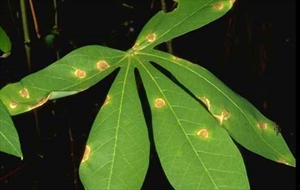Cassava brown leaf spot
Pacific Pests, Pathogens, Weeds & Pesticides - Online edition
Pacific Pests, Pathogens, Weeds & Pesticides
Cassava brown leaf spot (095)
Passalora henningsii; previously, Cercosporidium henningsii, Cercospora henningsii. It is also known as Mycospaerella henningsii, after the sexual state.
In the tropics. Asia, North, South, Central America, the Caribbean, Oceania. It is recorded from American Samoa, Cook Islands, Fiji, French Polynesia, Federated States of Micronesia, New Caledonia, Niue, Palau, Papua New Guinea, Samoa, Solomon Islands, Tonga, and Vanuatu.
Cassava
The disease usually occurs on the older, lower leaves, and is more noticeable 5-6 months after planting. Leaves fall prematurely.
Leaf spots are circular, up to 15 mm diameter, becoming angular and limited by veins (Photos 1&2). The spots are brown on upper surfaces with dark borders, sometimes surrounded by indistinct yellow margins. On the underside, the spots are grey with less distinct borders. Minor veins crossing the spots appear as black necrotic lines. The centres of the spots dry, crack and may fall out. As the spots enlarge, the leaves yellow and fall off.
Warm, humid weather increases the severity of the disease. Spores of the fungus produced on the lower surface are spread by wind and water-splash. Long distance spread occurs when spores are carried on planting material. In general, older leaves are more susceptible to the disease (Photo 2). The fungus can continue to live on old fallen leaves.
Losses in root yield of up to 30% have been reported from Africa, up to 23% in South America, and 17% in India. However, serious defoliation requiring disease control has not been reported in Pacific island countries. The disease is usually late in the growth of the plants, and only on the older leaves. If control measures were required, reduce plant density (i.e., increase the spacing between plants) to lower the humidity within the plantation.
Look for angular and round light brown spots with yellow margins on the older leaves.
CULTURAL CONTROL
The disease is of minor importance, and good cultural practices should reduce any potential impact:
Before planting:
- Plant at wide spacing, allowing the wind to dry the leaves as quickly as possible.
- Practice crop rotations of 3-5 years.
- Plant in the wet season, so that crops are in the susceptible stage (6-8-months-old) in the dry season.
- Do not plant new crops next to old ones with the disease.
During growth:
- During the dry season remove heavily diseased leaves to prevent the fungus spreading quickly when the rains start.
After harvest:
- Collect and burn debris.
RESISTANT VARIETIES
Varieties are not known with resistance to the disease in the Pacific islands, although in other regions there are reports of differences. Check if varieties differ in the amount of leaf loss, and choose those with the least damage.
CHEMICAL CONTROL
For chemical control, if warranted, copper fungicides or mancozeb.
____________________
When using a pesticide, always wear protective clothing and follow the instructions on the product label, such as dosage, timing of application, and pre-harvest interval. Recommendations will vary with the crop and system of cultivation. Expert advice on the most appropriate pesticides to use should always be sought from local agricultural authorities.
AUTHORS Helen Tsatsia & Grahame Jackson
Information from (including Photo 1) McKenzie E (2013) Passalora henningsii PaDIL - (http://www.padil.gov.au).
Produced with support from the Australian Centre for International Agricultural Research under project PC/2010/090: Strengthening integrated crop management research in the Pacific Islands in support of sustainable intensification of high-value crop production, implemented by the University of Queensland and the Secretariat of the Pacific Community.





